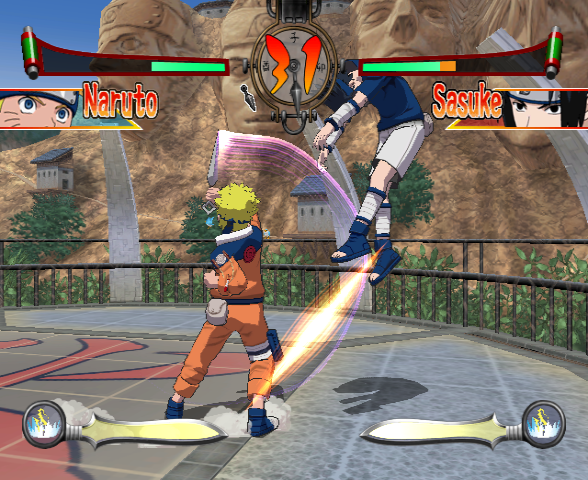

Long ago, I vividly remember owning this game thanks to my brothers and their Gamecube, playing it a lot with them and having so much stuff from it stuck into my head. Nowadays, while the game does hold up in a lot of ideas, most of it doesn't as it would get superseded by the sequels it got...but I definitely wanted to talk about this game from the stuff that it did right from the beginning, the shortcomings that would get adressed in the next entries of the series, and defining its unique gameplay so that covering the sequels can have more focus on.
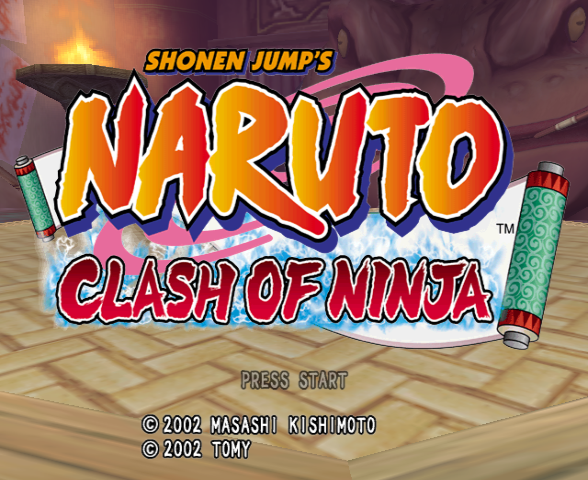
This game was made and released right off as the very first arc of Naruto's anime was done, and as such, the roster comprised of the three main protagonists, their master Kakashi, Iruka Umino who was important to Naruto at the very beginning of the series, the two arc villains Haku and Zabuza, and Rock Lee, who is introduced at the very end of this first arc and is unlocked after completing the Story mode, which does feel more like a glorified Arcade mode as while events are briefly covered, you basically fight everyone in the roster as Naruto (even though there are fights that aren't fought as him in the original story). While the modes might look relatively robust with an Arcade mode, a VS CPU mode, Time Attack, Survival, Training, and the aforementioned Story mode, it definitely pales today due to the small roster.
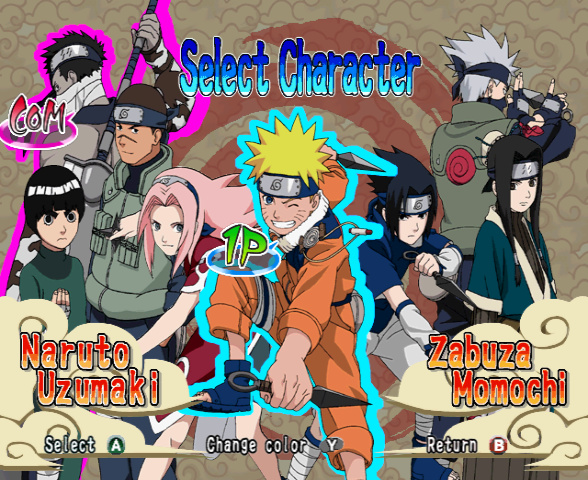
However, barring the small amount of content due to what's covered, Naruto Clash of Ninja does everything else well for the most part. While some stuff like Lee's outfit color is off and Naruto's super attack uses sprites for the clones instead of models, there's a variety of stages to fight at from the series, the character models themselves hold up well enough due to the cel-shaded approach to them, the soundtrack is fitting for stages and some of them are awesome to hear during a fight (even the character select music on this game had no right to be as good as it is), unique details like Haku's mask falling off if attacked enough and a special intro between Naruto and Sasuke, and the absolute highlight that this game provided for the sequels to build upon was the gameplay: This game was developed by 8ing and actually reused the Bloody Roar Primal Fury engine for this game, but the approach it takes for the controls is entirely different to virtually any other fighting game you've ever played.
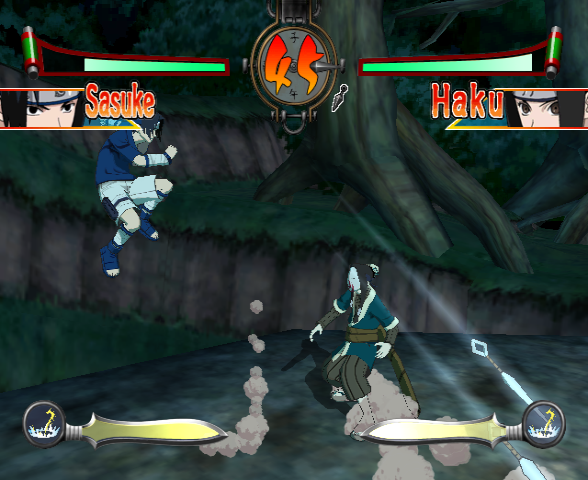
The B button is the main button for attacks, the A button is used by almost every character (Lee being the exception) to throw projectiles like kunais and shurikens in the ground and mid-air. Each character also has strings that use both buttons, most of them being started with the B button (there's a combo list for each character included as well), and the X button with a full chakra bar initiates an unblockable super attack if landed. You can use the Y button as well to use a throw if close enough, L/R triggers to sidestep, and pressing L or R while being attacked will use three thirds of the bar to substitute and attack the enemy from behind (think of it as a "Burst" move). The control scheme is simple enough to understand for any beginner, not requiring any motion inputs to do stuff, which leaves more room for strategy on what you actually want to do.
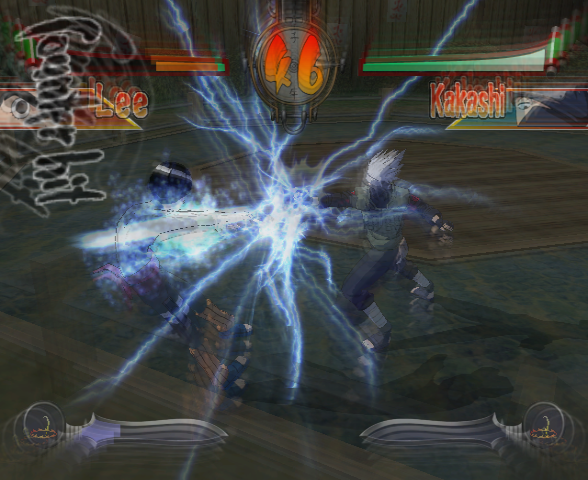
You can get other attacks if you press a direction while pressing the B button (Back + B often being an universal "guard attack" move where most of the startup has autoblocking) or the A button (more attacks or even "special attacks" like counters, traps, and so on). There's also an universal B, B, X combo which guarantees you the super attack if you hit the first two jabs, but it can be easily dodged by a jump if you were blocking, or escape before the super lands if you can substitute, so you must be mindful of the other player's options. While having projectiles on a button might sound easy to spam them, you have both jumping and sidestepping to evade them (though you can't sidestep while running here), and throws can be used with a guarding player to have a free juggle opportunity (though the idea of landing a super through that is MUCH harder than it sounds like).
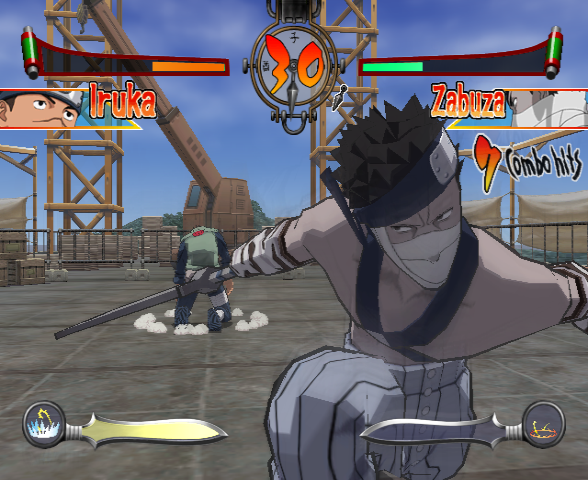
There is already a very solid base for a fun fighting game here, and while the characters that are avaliable here do have a variety of moves and unique flair for each one, there's definitely a shortcoming from having such a small roster hurting the replay value and the single player modes not having that much to offer unlock wise (aside from Nine-Tailed Naruto and Sharingan Kakashi which require you to beat Arcade mode with everyone and are accessed with a button instead of having a separate character slot). However, it was the perfect base to build upon for a sequel with more characters and content, adding more moves and mechanics, ironing out certain details, and so on. But as it stands, the first Naruto Clash of Ninja was a very interesting take to see, and a fun one to play, albeit rendered obsolete by the games that would follow after it.
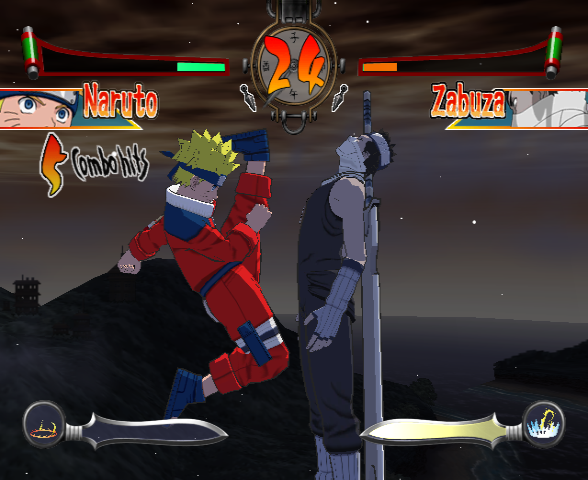

Spanish translation with DeepL. All screenshots were captured by myself.
Español
Hace mucho tiempo, recuerdo haber tenido este juego gracias a mis hermanos y su Gamecube, haber jugado mucho con ellos y tener muchas cosas de él metidas en la cabeza. Hoy en día, si bien el juego se mantiene en muchas ideas, la mayoría no lo hace ya que sería superado por las secuelas que tuvo... pero definitivamente quería hablar de este juego desde las cosas que hizo bien desde el principio, las deficiencias que se abordan en las siguientes entradas de la serie, y la definición de su modo de juego único para que la cobertura de las secuelas puede tener más enfoque en.

Este juego fue hecho y lanzado justo cuando el primer arco del anime de Naruto fue hecho, y como tal, el roster comprendió a los tres protagonistas principales, su maestro Kakashi, Iruka Umino quien fue importante para Naruto al principio de la serie, los dos villanos del arco Haku y Zabuza, y Rock Lee, que se introduce al final de este primer arco y se desbloquea tras completar el modo Historia, que se parece más a un modo Arcade glorificado, ya que, aunque los eventos se cubren brevemente, básicamente luchas contra todos los miembros de la lista como Naruto (aunque hay combates que no se libran como él en la historia original). Aunque los modos pueden parecer relativamente robustos, con un modo Arcade, un modo VS CPU, Time Attack, Survival, Training y el ya mencionado modo Historia, definitivamente palidecen hoy en día debido al reducido plantel.

Sin embargo, salvo por la escasa cantidad de contenido debido a lo que abarca, Naruto Clash of Ninja hace todo lo demás bien en su mayor parte. Aunque algunas cosas, como el color del traje de Lee, están fuera de lugar y el superataque de Naruto utiliza sprites para los clones en lugar de modelos, hay una gran variedad de escenarios en los que luchar de la serie, y los propios modelos de los personajes se mantienen bastante bien debido al enfoque cel-shaded que se les ha dado, la banda sonora es adecuada para las fases y algunas de ellas son increíbles para escuchar durante una pelea (incluso la música de selección de personajes en este juego no tenía derecho a ser tan buena como lo es), detalles únicos como la máscara de Haku que se cae si se le ataca lo suficiente y una introducción especial entre Naruto y Sasuke, y lo más destacado que este juego proporcionó para las secuelas a construir fue la jugabilidad: Este juego fue desarrollado por 8ing y, de hecho, reutilizó el motor de Bloody Roar Primal Fury para este juego, pero el enfoque que adopta para los controles es totalmente diferente al de prácticamente cualquier otro juego de lucha al que hayas jugado.

El botón B es el principal para los ataques, el botón A es utilizado por casi todos los personajes (Lee es la excepción) para lanzar proyectiles como kunais y shurikens en el suelo y en el aire. Cada personaje tiene también cadenas que utilizan ambos botones, la mayoría de las cuales se inician con el botón B (también se incluye una lista de combos para cada personaje), y el botón X, con la barra de chakra llena, inicia un superataque imbloqueable si se consigue. También puedes usar el botón Y para lanzarte si estás lo suficientemente cerca, los botones L/R para esquivar, y si pulsas L o R mientras te atacan, usarás tres tercios de la barra para sustituir y atacar al enemigo por detrás (piensa en ello como un movimiento "Burst"). El esquema de control es lo suficientemente sencillo como para que lo entienda cualquier principiante, ya que no requiere ninguna entrada de movimiento para hacer cosas, lo que deja más espacio para la estrategia sobre lo que realmente quieres hacer.

Puedes conseguir otros ataques si pulsas una dirección mientras presionas el botón B (Atrás + B suele ser un movimiento universal de "ataque de guardia" en el que la mayor parte del inicio tiene autobloqueo) o el botón A (más ataques o incluso "ataques especiales" como contadores, trampas, etc.). También hay un combo universal B, B, X que te garantiza el superataque si aciertas los dos primeros golpes, pero puede ser fácilmente esquivado con un salto si estabas bloqueando, o escapar antes de que caiga el superataque si puedes sustituirlo, así que debes estar atento a las opciones del otro jugador. Mientras que tener proyectiles en un botón puede parecer fácil para spamearlos, tienes tanto el salto como el esquive para evadirlos (aunque no puedes esquivar mientras corres aquí), y los lanzamientos pueden ser usados con un jugador en guardia para tener una oportunidad de malabarismo libre (aunque la idea de aterrizar un súper a través de eso es MUCHO más difícil de lo que parece).

Ya existe una base muy sólida para un juego de lucha divertido, y aunque los personajes disponibles tienen una gran variedad de movimientos y un estilo único para cada uno de ellos, el hecho de tener una lista tan pequeña perjudica el valor de la rejugabilidad y los modos para un jugador no tienen mucho que ofrecer en cuanto a desbloqueo (aparte de Naruto de nueve colas y Kakashi con Sharingan, que requieren que superes el modo Arcade con todos los personajes y a los que se accede con un botón en lugar de tener una ranura de personaje separada). Sin embargo, era la base perfecta sobre la que construir una secuela con más personajes y contenido, añadiendo más movimientos y mecánicas, limando ciertos detalles, etc. Pero, tal y como está, el primer Naruto Clash of Ninja era un juego muy interesante y divertido, aunque quedó obsoleto por los juegos que le siguieron.


Traducción al español hecha con DeepL. Todas las fotos capturadas por mí.